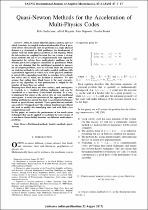JavaScript is disabled for your browser. Some features of this site may not work without it.
- ResearchSpace
- →
- Research Publications/Outputs
- →
- Journal Articles
- →
- View Item
| dc.contributor.author |
Haelterman, R

|
|
| dc.contributor.author |
Bogaers, Alfred EJ

|
|
| dc.contributor.author |
Degroote, J

|
|
| dc.contributor.author |
Boutet, N

|
|
| dc.date.accessioned | 2018-02-21T08:28:53Z | |
| dc.date.available | 2018-02-21T08:28:53Z | |
| dc.date.issued | 2017-08 | |
| dc.identifier.citation | Haelterman, R. et al. 2017. Quasi-Newton methods for the acceleration of multi-physics codes. IAENG International Journal of Applied Mathematics, vol. 47(3): 352-360 | en_US |
| dc.identifier.issn | 1992-9978 | |
| dc.identifier.uri | http://www.iaeng.org/IJAM/issues_v47/issue_3/IJAM_47_3_17.pdf | |
| dc.identifier.uri | http://www.iaeng.org/IJAM/issues_v47/issue_3/index.html | |
| dc.identifier.uri | http://hdl.handle.net/10204/10049 | |
| dc.description | Article published in IAENG International Journal of Applied Mathematics, vol. 47(3): 352-360 | en_US |
| dc.description.abstract | Often in nature different physical systems interact which translates to coupled mathematical models. Even if powerful solvers often already exist for problems in a single physical domain (e.g. structural or fluid problems), the development of similar tools for multi-physics problems is still ongoing. When the interaction (or coupling) between the two systems is strong, many methods still fail or are computationally very expensive. Approaches for solving these multi-physics problems can be broadly put in two categories: monolithic or partitioned. While we are not claiming that the partitioned approach is panacea for all coupled problems, here we will only focus our attention on studying methods to solve (strongly) coupled problems with a partitioned approach in which each of the physical problems is solved with a specialized code that we consider to be a black box solver and of which the Jacobian is unknown. We also assume that calling these black boxes is the most expensive part of any algorithm, so that performance is judged by the number of times these are called. Running these black boxes one after another, until convergence is reached, is a standard solution technique and can be considered as a non-linear Gauss-Seidel iteration. It is easy to implement but comes at the cost of slow or even conditional convergence. A recent interpretation of this approach as a rootfinding problem has opened the door to acceleration techniques based on quasi-Newton methods. These quasi-Newton methods can easily be "strapped onto" the original iteration loop without the need to modify the underlying code and with little extra computational cost. In this paper, we analyze the performance of ten acceleration techniques that can be applied to accelerate the convergence of a non-linear Gauss-Seidel iteration, on different multi-physics problems. | en_US |
| dc.language.iso | en | en_US |
| dc.publisher | International Association of Engineers | en_US |
| dc.relation.ispartofseries | Worklist;19477 | |
| dc.subject | Iterative methods | en_US |
| dc.subject | Partitioned methods | en_US |
| dc.subject | Quasi-Newton | en_US |
| dc.title | Quasi-Newton methods for the acceleration of multi-physics codes | en_US |
| dc.type | Article | en_US |
| dc.identifier.apacitation | Haelterman, R., Bogaers, A. E., Degroote, J., & Boutet, N. (2017). Quasi-Newton methods for the acceleration of multi-physics codes. http://hdl.handle.net/10204/10049 | en_ZA |
| dc.identifier.chicagocitation | Haelterman, R, Alfred EJ Bogaers, J Degroote, and N Boutet "Quasi-Newton methods for the acceleration of multi-physics codes." (2017) http://hdl.handle.net/10204/10049 | en_ZA |
| dc.identifier.vancouvercitation | Haelterman R, Bogaers AE, Degroote J, Boutet N. Quasi-Newton methods for the acceleration of multi-physics codes. 2017; http://hdl.handle.net/10204/10049. | en_ZA |
| dc.identifier.ris | TY - Article AU - Haelterman, R AU - Bogaers, Alfred EJ AU - Degroote, J AU - Boutet, N AB - Often in nature different physical systems interact which translates to coupled mathematical models. Even if powerful solvers often already exist for problems in a single physical domain (e.g. structural or fluid problems), the development of similar tools for multi-physics problems is still ongoing. When the interaction (or coupling) between the two systems is strong, many methods still fail or are computationally very expensive. Approaches for solving these multi-physics problems can be broadly put in two categories: monolithic or partitioned. While we are not claiming that the partitioned approach is panacea for all coupled problems, here we will only focus our attention on studying methods to solve (strongly) coupled problems with a partitioned approach in which each of the physical problems is solved with a specialized code that we consider to be a black box solver and of which the Jacobian is unknown. We also assume that calling these black boxes is the most expensive part of any algorithm, so that performance is judged by the number of times these are called. Running these black boxes one after another, until convergence is reached, is a standard solution technique and can be considered as a non-linear Gauss-Seidel iteration. It is easy to implement but comes at the cost of slow or even conditional convergence. A recent interpretation of this approach as a rootfinding problem has opened the door to acceleration techniques based on quasi-Newton methods. These quasi-Newton methods can easily be "strapped onto" the original iteration loop without the need to modify the underlying code and with little extra computational cost. In this paper, we analyze the performance of ten acceleration techniques that can be applied to accelerate the convergence of a non-linear Gauss-Seidel iteration, on different multi-physics problems. DA - 2017-08 DB - ResearchSpace DP - CSIR KW - Iterative methods KW - Partitioned methods KW - Quasi-Newton LK - https://researchspace.csir.co.za PY - 2017 SM - 1992-9978 T1 - Quasi-Newton methods for the acceleration of multi-physics codes TI - Quasi-Newton methods for the acceleration of multi-physics codes UR - http://hdl.handle.net/10204/10049 ER - | en_ZA |






